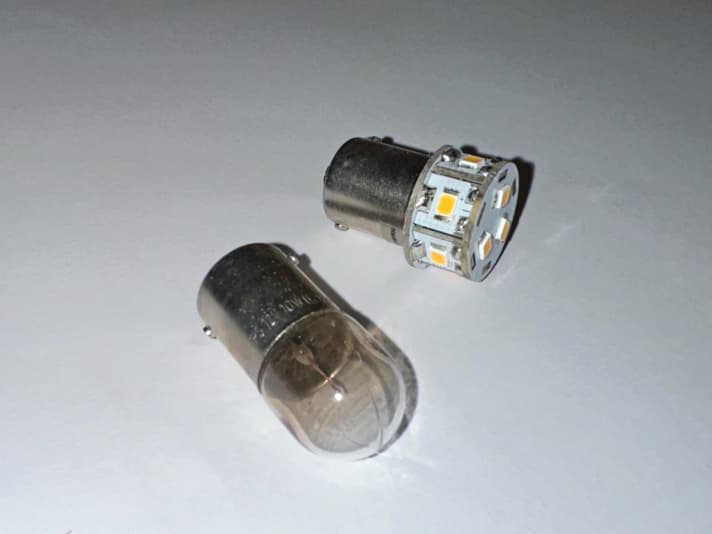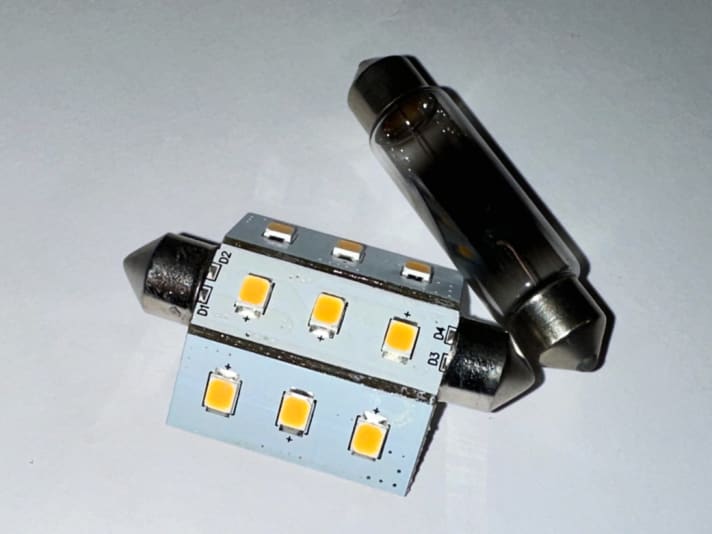





Good lighting below deck has many functions. In addition to the practical benefit of being able to see better, it also creates a cosy atmosphere and lifts the mood. When travelling on the water, there is also the safety aspect. If you are working in the galley on a rocking boat with poor lighting, for example, the risk of injury increases.
Incandescent lamps are still installed on many older boats. Although these provide a particularly warm and pleasant light, they also consume a lot of electricity, so it is better to use the cosy illumination sparingly.
Otherwise, the lighting below deck can quickly become the largest consumer on board. And even before the refrigerator and navigation instruments. Then the power reserves run out very quickly at sea and the diesel has to run at anchor. What's more, light bulbs also have a very short service life. They have to be replaced regularly. A simple solution to these problems is LED lighting.
What you should know before retrofitting
There are two options for the conversion: replacing the old lamps with new ones or simply changing the light sources from light bulbs to LEDs. Lamps are expensive and the conversion takes time, but they may also have the added value of a USB connection. The light sources, on the other hand, can be replaced quickly and the changeover is also quite inexpensive.
In this example, we have changed the lamps on a 32-foot boat. There are a total of 13 lamps with four different sockets below deck. In the end, five different LED light sources were used during the conversion.
LED stands for light-emitting diode. Made from semiconductor material, these light sources emit a very specific light spectrum depending on their properties. This allows different light colours to be achieved and significantly less energy is required. This is because with the classic incandescent lamp, a current is simply passed through a thin wire until it glows. The emitted light spectrum can hardly be influenced and only a small part of it is visible to the human eye. A large percentage is in the infrared range of the light spectrum. This is why incandescent lamps are also known as heat emitters. Strictly speaking, classic light sources are small heaters that also emit a little light. Most of the energy is required for the waste heat. This is why LEDs sometimes only need a tenth of the electricity. However, the incandescent lamp has two advantages: it usually produces a beautifully warm, yellowish light that is perceived as particularly pleasant and emits it in all directions. But LED light sources can now also score points here. LEDs also have a service life of up to 50,000 hours (which corresponds to 5.7 years of continuous operation). By comparison, incandescent lamps have an average service life of around 1,000 hours.
Due to the much lower power consumption, brighter LEDs can also be selected, which then better illuminate areas that were previously poorly lit, without having to modify the lamp. Nevertheless, the new light source then consumes much less power than the incandescent lamp with fewer lumens. Different light colours can also be switched. For example, to switch to red light, which is less dazzling, when driving at night. LED light sources are available that can be easily switched over. No new switch is required for this. The electronics in the light source recognise when the light is switched on, off and on again in quick succession and then switches from white to red light. But electronics are not only installed on these special lights; all light sources from the manufacturer NauticLED, for example, have a control system that compensates for one disadvantage: the LEDs are sensitive to voltage and current fluctuations, which means they age more quickly. The control system always supplies them with the right current. This is why the manufacturer specifies a voltage of 10 to 35 volts. This means that they can be used on boats with 12 or 24 volt on-board voltage.
Converting to LED light sources step by step
Converting to LED lamps is a rewarding winter job, as it is mostly done at home. Firstly, all the old bulbs are removed on board. Then the research begins at home to find out which sockets are available. Here it helps a lot to have a look at the website of an outfitter, in our case Gotthardt Yacht. It is generally possible to order all light sources individually from different shops. However, if you limit yourself to one manufacturer, it is easier to get all the bulbs in the same light colour. A wild mix of different shades of white will be a nuisance later on board.
Gotthardt has two brands in its range: Båtsystem and NauticLED. If you are unsure exactly which socket you are dealing with, measure the old bulbs and compare the data with the manufacturer's specifications. For example, BA 15S and BA 9S look the same and differ only in their dimensions (the number in the designation stands for the diameter). The most common bulbs on board are those with a bayonet fitting with two pins on the side, as with the BA 15S. There is also the G4 socket with two elongated contacts that are simply plugged into the corresponding openings in the lamp socket. The cylindrical bulbs with one contact at each end are called Sofitten and are available in different lengths. They are easy to measure.
There are also various adapters on the market, so bulbs with a G4 connection can be used in all lamps. The advantage would be that only one type of bulb would have to be taken along as a replacement. However, the LED with the adapter may also be higher and protrude out of the lampshade, which then causes glare and does not provide a good beam angle.
The manufacturer also states the actual output and what a corresponding light bulb would achieve. So if you were satisfied with the illumination on board, you can make a one-to-one comparison here.
As the beam angle of an LED is smaller than that of an incandescent lamp, manufacturers use a trick. Several LEDs with different orientations are housed in one light source. This makes sense because the lamps on board were designed for light bulbs. These also shine backwards, i.e. into the lamp. To utilise this light as well, there is a reflector there. A large proportion of the light is therefore not emitted directly from the bulb, but indirectly from the lampshade. Here, the NauticLED range offers various designs in order to achieve beam angles as similar as possible to those of light bulbs. This works very well in practice.
Was the change worth it?
Once all the types have been determined, all you have to do is order the right number. Installation on board only takes a few moments, and in the best-case scenario there is hardly any recognisable difference to the old bulbs. So was it worth it, and what are the measurable benefits?
On the example boat, 13 lamps were installed below deck, which together had an impressive 135 watts of power. When they were all switched on at the same time, they drained a 100 ampere-hour lead-acid battery in just under four and a half hours. Madness! The same number of lamps, some of which have more lumen in LED lamps, have an output of 15.4 watts. This means that they consume just over a tenth of the original energy consumption. All the lamps could now shine for 39 hours with the same battery.
The cost of all light sources is 242.10 euros. This is considerably more than for comparable light bulbs, but the advantages outweigh this. The alternative of converting not only the light sources but all the lamps would far exceed this sum.
And with the new lamps, a boat can be illuminated much more generously below deck. This makes it more cosy in the evening and the crew doesn't have to worry if a lamp is accidentally left on.
Old versus new: which light sources are on board?
NauticLED G4 T12

- Performance: 0.8 watts (replaces 10 watts)
- Light colour: 2,700 Kelvin Price: 16.50 euros
- The small light sources with G4 pin are often installed in reading lamps or spotlights on the bunk, for example. The dimensions are 8 by 22 millimetres
NauticLED BA 9S MT12

- Performance: 0.8 watts (replaces 10 watts)
- Light colour: 2,700 Kelvin
- Price: 16,50 Euro
- The BA-9S socket measures just 9 x 38 millimetres and fits, for example, into the navigation desk lamp with flexible gooseneck from the manufacturer Hella
NauticLED BA 15S T09

- Performance: 1.4 watts (replaces 10 watts)
- Light colour: 2,700 Kelvin
- Price: 20,50 Euro
- Nine LEDs instead of one filament. The light source with BA-15S socket can be found in many reading lamps. The large number of LEDs provides beautiful beam angles
NauticLED F42-9

- Performance: 2.0 watts (replaces 15 watts)
- Light colour: 2,700 Kelvin
- Price: 18,50 Euro
- The cylindrical light sources are called Sofitten and are often found in ceiling lamps on boats or in campers. Nine LEDs have advantages in terms of brightness and beam angle
NauticLED G4 Dual Colour 9

- Performance: 1.4 watts (replaces 10 watts)
- Light colour: 2,700 Kelvin + red light
- Price: 26,90 Euro
- Real added value: Any lamp with a red light function can be retrofitted with this LED light source. The light modes are changed by pressing the switch several times - so the interior lighting is immediately ready for night-time driving
Conclusion on converting to LED light sources
LED light sources are quite expensive compared to light bulbs. However, the advantages on board outweigh the disadvantages. The more appropriate comparison, however, would be LED lamps versus new lamps with LEDs. Here, a single new lamp can already exceed the price of 13 bulbs
- Power consumption with LED: 15.4 Wh
- Power consumption with light bulbs: 135.0 Wh
- Savings: 88,6 %
- Price for LED light sources: 242,10 Euro
- Price of light bulbs, for example: 14,00 Euro
- Proof of delivery: www.gotthardt-yacht.de

